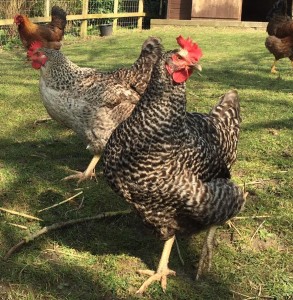News
Mycoplasma in Poultry
by admin on May 30th, 2017
Category: News, Tags:
The ‘Head Cold’ of the Poultry World
As more and more pet owners are keeping poultry we felt it appropriate to look at one of the most common infections that may be seen.
The main culprit of Mycoplasma infection in backyard poultry is Mycoplasma gallisepticum. This is one of the organisms that makes up the colloquially-termed ‘chronic respiratory disease syndrome’ (potentially in association with Infectious Laryngotracheitis) in poultry worldwide. It is considered to be responsible for some of the greatest economic losses throughout commercial flocks around the globe, but can just as easily impact on smaller backyard flocks.
Who catches Mycoplasma, and how?
Poultry, including chickens and turkeys, are most often presented with respiratory issues involving Mycoplasma gallisepticum, but a wide range of other birds including pheasants and wildfowl can be affected.
Mycoplasma gallisepticum can be spread vertically (from hen to egg) leading to infected chicks, or, and perhaps more commonly, through horizontal transmission (bird to bird). The disease can be spread short distances through the air as an aerosol, or on shoes/water drinkers/feeders. The disease itself may remain dormant within the infected bird for potentially months before causing any overt clinical disease. It is often at this stage that rapid spread of the disease occurs throughout a flock.
What does Mycoplasma in poultry look like?
Focusing on the presenting signs of poultry, the degree of clinical signs can vary widely from no apparent signs up to the potential death of the bird in more aggressive, complicated disease development.
The more common presenting signs can include:
- Rales (clicking, rattling, or crackling noises)
- Coughing
- Nasal discharge
- Discharge from around the eyes
- Swelling under the eyes
In more advanced cases, sinusitis may become apparent.
There may also be more generic signs of illness present including the birds appearing fluffed up, off food, keeping themselves away from the rest of the flock and reduction in egg production or going off lay completely.
Clinical signs are often quicker to develop and more severe in turkeys than chickens.
Can Mycoplasma in poultry be treated?
Mild to moderate disease can be treated successfully with appropriate antibiotics prescribed by your vet, pain relief and good nursing management (TLC!). It is important to note however that once your bird/flock has suffered from the disease, it likely to circulate and be present from thereon in. This becomes an important factor when either bringing in new birds or selling/moving your own birds.
Chickens, as well as most other birds, will suffer a much more marked immune ‘crash’ when stressed in comparison to other animals. This means that when birds are moved to a new location or mixed with other birds, the stress can induce a marked reduction in their active immunity causing a rapid onset of disease symptoms (sneezing, coughing, etc.).
Due to the risk of disease spread amongst new birds, it is absolutely vital to quarantine any incoming birds for at least 3-4 weeks to ensure that you are not putting your own birds at risk of disease.
Prevention is better than cure!
Vaccinations are available against certain strains, but use of a vaccine must be with caution as quarantine procedures would still always be advised, and any new birds bought in would have to have been vaccinated. The danger with vaccinating poultry is that all too often it is seen as an easily-achievable blanket cover for disease. Good biosecurity, involving washing boots, is important. Always thoroughly disinfect items that are brought in or taken off the holding containing your particular birds.
Responses are currently closed, but you can trackback from your own site.

